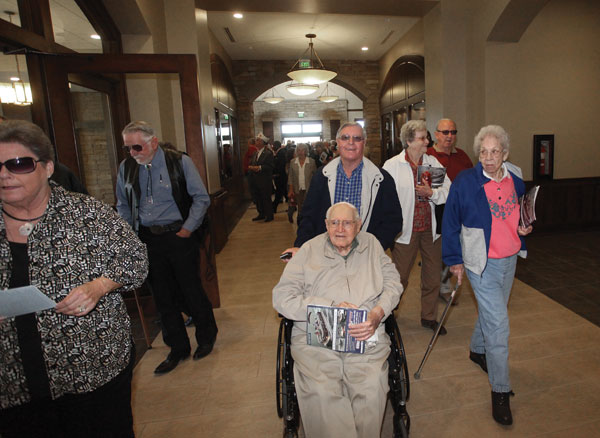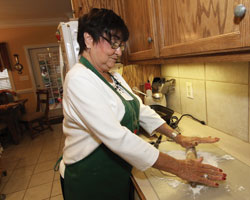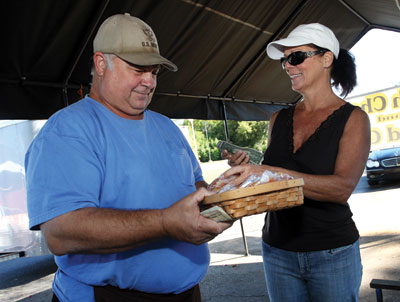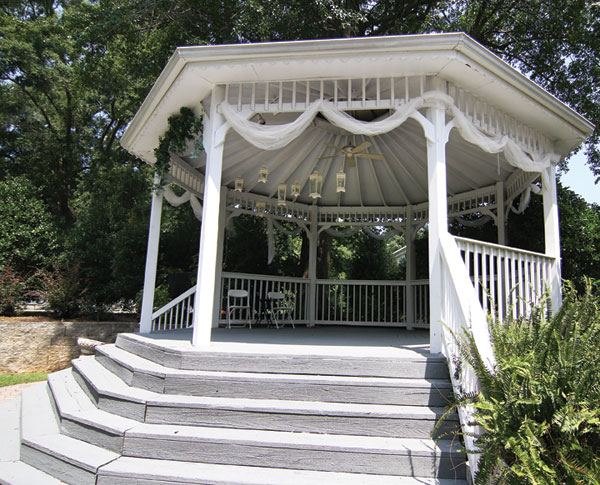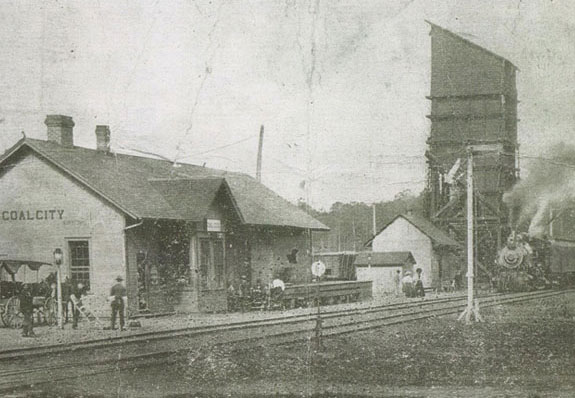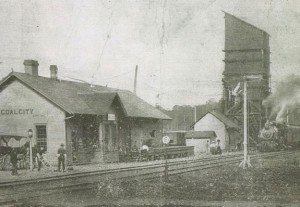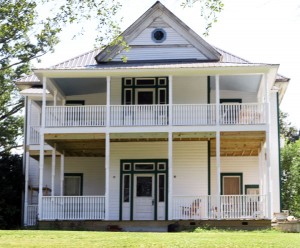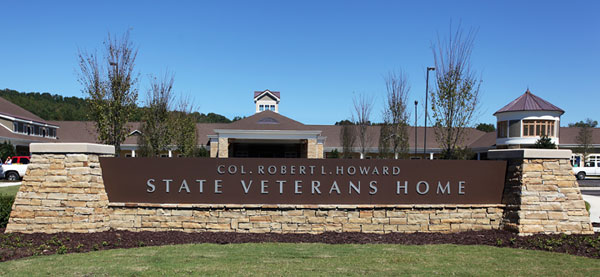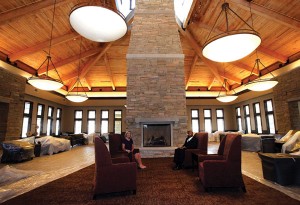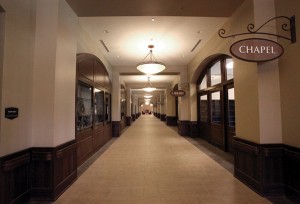Five Perfect Locations
Story by Carolyn Stern
Photos by Jerry Martin
Weddings create lifelong memories. The dress, the colors, the decorations and the food all must be chosen, hopefully pleasing both the bride and the groom. But what about the setting for the vows? That may be one of the most difficult decisions.
Here in St. Clair County, almost any wish can be granted. Whatever venue is desired: formal or natural, on top of a mountain, beside water, in a rustic barn or a meadow. At least five choices are available without even crossing the county line.
Mathews Manor
Since 2001, Debbie and Harold Mathews have been helping create memorable days for couples at Mathews Manor.
Debbie began her hospitality career as a caterer in 1980, and she eventually expanded her business to providing food for weddings. A cake-decorating class gave her a whole new skill that led her to a new adventure. It was only natural that she dreamed of having her own wedding venue. She put her plan into action when Harold’s parents had their Springville property for sale for a year without a buyer.
Harold and Reba Mathews built their Spanish-style stucco home in 1980 on a corner lot fronting Highway 11. Close to Springville’s business district, Debbie saw it as a perfect spot for her planned enterprise.
Harold was away from home (flying a Lear jet for corporate clients) when Debbie called him in Colorado. She started the conversation by saying, “Listen to my idea before you say, ‘No’”. He didn’t say “No.”
Debbie and Harold bought the property, which included a swimming pool, in December of 1999. Rather than demolishing the existing sturdy structure, they built around it. The sizes of some of the areas were expanded, and a second floor was added to a portion of the original house. After installing a commercial kitchen, Debbie hosted business meetings and public lunches in the tea room area.
The Mathews began booking weddings in 2001, and the tea room and the additional first floor space are now used for Rebecca’s Garden weddings or receptions. Couples may choose to have the ceremony inside or outside. A covered outdoor reception area also is available. The existing swimming pool has become a favorite wedding choice for starry nights. The Mathews added to the already well-landscaped surroundings, retaining the grapevines that had been planted and tended by Harold’s grandmother.
Two sons, Trey (wife, Tammy) and Tyler (Lindsay), help manage the maintenance of the extensive property. Daughter Traci Creel and her husband, Jason, live in Montgomery. The various sites on the property are named for grandchildren Rebecca, Grace, Amelia and Micah. Carson has yet to have his own feature.
The path through Rebecca’s Garden passes the Grandmother’s house, which now is used as a consulting office, and a large fountain is the centerpiece of the garden area. Next is Grace Hall, probably the most impressive of the venues, an 8,400-square-foot structure that can accommodate almost any sized wedding party, even if a full meal is planned. Accessed from the lobby, the bride’s spacious chamber has furniture for relaxing and a floor-to-ceiling mirror that will assure all the ladies will be appropriately groomed. So will the men, of course, who have their space just across the way. At the rear of the hall is a commercial kitchen (designed and installed by Harold) that, when necessary, has held more than 20 workers.
When land across Hwy. 11 became available, the family decided to expand their services. The first installation was Amelia’s Pumpkin Patch, which is open in October so visitors can pick pumpkins and enjoy games and treats. Harold’s next project has been Micah’s Meadow, planned for the couple who want a natural setting. A stone-based raised platform is the stage, and a lighted chandelier hangs between two of the large oak trees. Other lights make this a wonderland for evening events.
Harold describes an additional feature of the meadow celebration. “A horse-drawn carriage brings the bride over a stone bridge to the wedding stage,” he says, “and when the couple leaves the ceremony, the carriage takes them through Lover’s Lane.”
Debbie and Harold, who have been married for 39 years, agree that their favorite part of the wedding business is meeting the people involved. “It’s very touching to be part of someone’s special day,” says Debbie. “She always cries,” Harold adds.
Waterview Weddings & Events
Before she found her true calling, Audrey Odom studied art at the University of Montevallo and at UAB. But when she decorated a cake for her daughter’s third birthday, she realized that was how she wanted to express her creativity.
During the 30 years since, Audrey’s reputation for exceptional cakes has spread all over the state. Her creations have appeared in the Birmingham and Montgomery Museums of Art, and a recent event at Birmingham’s The Club featured a six-tiered cake for 300 people.
After some thought, Audrey and her husband, Phillip, decided a wedding venue was the next step. The first order of business was finding a suitable location, and it wasn’t easy to find, says Audrey. They finally discovered one that satisfied both of them: a one-story, brick building that had formerly housed a restaurant.
“The large parking lot was what caught Phillip’s interest because we knew parking would be an issue for a wedding site,” explains Audrey. “I saw the space inside and was already planning how each area could be used.”
In January of this year, Waterview Weddings came to Riverside. Audrey still provides cakes for weddings at other locations, but Waterview is her dream. Many days, Audrey and Phillip take cake layers in coolers, in their van and SUV, to assemble and decorate at various wedding sites and then return to Waterview to prepare for their own events.
Audrey treats every cake as special. A popular cake flavor is French vanilla almond, she says, but she will create the flavor and look that the bride chooses. Brides sometimes send her photos of their wedding gowns and ask that she echo something in the design on the cake. “It’s fun to see what they envision,” she says.
One bride whose dress had satin-covered buttons down the back requested frosting replicas of them down the tiers of the cake. That detail was added. Audrey also has sculpted lace and other trim to match wedding dresses.
This cake artist says she welcomes “whimsical” ideas. “One bride wanted to surprise her groom with a cake shaped like an 18-wheeler because he drives a truck,” Audrey says. “It got a lot of attention.”
One reason Audrey can balance her “double-duty” is that she allows the couple to work out the details of their special celebration. The bride and her helpers plan and place the decorations in the ballroom and the outside spaces. The couple chooses the food to be served, from appetizers to dessert, and Audrey and her staff prepare it. The wedding can be conducted in the dining room-ballroom or outside on the 12-foot-by-24-foot deck that’s on a quiet inlet of Lake Logan Martin. Not surprisingly, most choose the deck.
Some things Audrey just can’t leave to others. “I’m all about romance,” she says, “and I want to make the couple’s wedding day as perfect as possible.” She adjusts the cafe lighting inside the ballroom to fit the mood, which, of course, can be counted on to increase the romance factor. She chose the globe lights that seem to float above the dance floor. The adjacent covered patio has chandeliers that Audrey lovingly collected and painted white. “They cast a golden glow,” she explains.
That’s romance.
Sweet Apple Farm
Just a year ago, Miss Tina began opening her 80-acre private estate to brides and grooms who are looking for a unique wedding venue. Even before opening, she says, she had requests from prospective guests who wanted to know more.
“I hadn’t even gotten my site up, and I was already hearing from people who had seen postings on Facebook,” says Miss Tina, the name she goes by.
“I’m in my late 50s,” she explains, “and decided I was ready to move from Miami and find a place I loved.” After crisscrossing the country for a while and not finding that place, she posted her requirements on the Internet. “I wanted rolling green hills, water on the property, trees and a project.”
Alabama was not really in her plans. But a reply came from our state. She says her reaction was “WHAT?”
However, the property met all of her criteria. She came, she saw, she bought.
Then her project began. She had been a general contractor in Miami, but she had to convince local workers that she knew what she was talking about when it came to building and restoring.
The main wedding spot is the barn, which had been home to cows and pigs for years. After numerous hours spent cleaning, repairing and adding features, it now has new hardwood floors, as well as crystal chandeliers, making it the most popular place for weddings. Tina says the wedding couple’s family may furnish their own food and use the kitchen in the barn, thus saving a catering fee.
The Country Cottage (once a garage) can serve as a relaxation and dressing area or as a space for overnight wedding guests. An 1841 log cabin can be used for the bride and bridesmaids before the ceremony, for overnight wedding guests or as a honeymoon suite.
A small chapel in the woods is available for couples who want to keep their wedding simple. It is suitable for up to 32 guests, and the family and guests may provide their own meal or refreshments.
After putting the “frosting on the cake” of her dream property, Miss Tina is now settled in her new state and providing an elegant rustic setting for many happy occasions.
Creel Chapel
Camp Sumatanga, where untold numbers of campers have spent glorious summer days, is fairly well known in the state. But the idea of holding a wedding at the Sumatanga Camp and Conference Center most likely would be a surprise to those couples who might be searching for just what it offers.
This 1,700-acre property runs alongside and up the side of Chandler Mountain. The name, “Sumatanga,” is said to be a Himalayan word meaning “a place of renewal and reflection.” This was the purpose the founders envisioned for the original site. In 1965, that spirit was carried to the mountaintop with the establishment of Creel Chapel.
Named for Judge E.M. Creel and built in 1964, the chapel was originally used only for individual meditation or prayer. Drawn by descriptions of its fabulous view, couples now are choosing it as their wedding site.
The small, open structure has a lofty timbered metal roof supported by native stone pillars. Stone steps (that can provide standing room for 50 wedding guests) lead to an altar with a cross silhouetted against the sky. Beyond is an exceptional view of distant mountains. The view, coupled with the silence of the forest around the site, create an incomparable mood.
Matthew Johnson, executive director, says small weddings also can be held at the Lakeside Amphitheater on the main campus, and three pavilions are available for receptions. Lodging for overnight or out-of-town guests is no problem.
Sumatanga has found yet another way to reach out to people who are making important life decisions.
Mountainview Gardens and Ballroom
Debbie and Charlie Lewis have hosted about 700 weddings since they opened their wedding site on Simmons Mountain in 2003. The most interesting occurrence, says daughter Misty Watkins (the wedding director), was when “a helicopter delivered the bride to the front lawn.” And that’s not all.
“After the wedding,” she adds, “a professional pyrotechnic team produced an awesome fireworks show.”
Debbie says her first weddings were in churches and school gyms. “We used a rented trailer to carry all the things that were needed, loading at home, unloading at the site, then loading and unloading again.”
When the Lewis’ children, Charlie and Misty, left home, it didn’t take long for Debbie to see she had a wonderful opportunity that didn’t require any loading and unloading. Charlie is a contractor and had built their two-story home to fit a family. Debbie had spent a lot of time collecting antiques and decorating the house to perfection. Why not use it to help couples begin their life together?
The 11 acres on which the house sits offered numerous opportunities for creating garden areas for a ceremony or for photos. The existing swimming pool could become a wedding feature. And there also was the outstanding view.
Charlie added a window-lined ballroom to the back of the house to provide more open space for receptions, dinners or dancing. In inclement weather, it also can be used for the ceremony. On one side of the home, the garden is the wedding spot. A picturesque gazebo offers a terrific photo opportunity. On the other side, the pool takes center stage. The ceremony platform has stately Greek columns, and a waterfall flows into the swimming pool.
“I direct the ceremony and the receptions of the weddings, and my mother does the catering,” says Misty. “She did it all until I started helping.”
On the first floor of the main house, the bride and bridesmaids have a room decorated with some of Debbie’s finds from antique shops, including a round velvet settee. The groom and his entourage have a space on the second floor that includes a pool table and a large-screen TV.
Debbie isn’t worried about the future of her business if she decides she’s had enough. “Misty could take it over,” she says, and, eventually, so could Misty’s daughter. “One time I was taking her into the kitchen,” Debbie adds, “and she told me to tell the ‘people in the kitchen that I’m the boss’”.
This is a busy family. Misty and her husband, Bryan, have five children, who are home-schooled. Misty has an additional one-day job out of the home. Bryan, as well as Misty’s father and her brother, are all firefighters. A couple of cousins make five in the family.
Bryan also is qualified to perform a wedding ceremony, says Misty, and is a deputy sheriff. Charlie, the father, and Charlie, the son, do almost all of the maintenance necessary on the property.
Debbie says her favorite part of the wedding process is “seeing the look on the bride’s face when she comes into the reception area and sees all of the decorations and the cake. That’s worth all our effort.”
Misty adds, “I love being involved with their day and making it as special as the couple could want.”
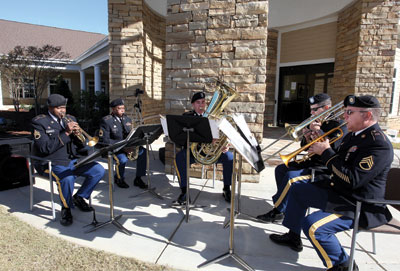 Shirley McConico echoed the sentiment, noting that the proximity of Vincent to Pell City will make her travel for visits easier.
Shirley McConico echoed the sentiment, noting that the proximity of Vincent to Pell City will make her travel for visits easier.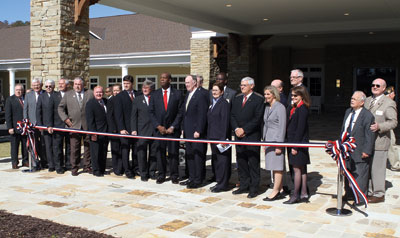 Williams Blackstock was the architectural firm for the project, and Marsh noted that its design says style “from beam to beam and stern to stern.” He also thanked Doster Construction for delivering “a magnificent building. They stepped up to meet each challenge” for the state’s largest veterans home.
Williams Blackstock was the architectural firm for the project, and Marsh noted that its design says style “from beam to beam and stern to stern.” He also thanked Doster Construction for delivering “a magnificent building. They stepped up to meet each challenge” for the state’s largest veterans home.











